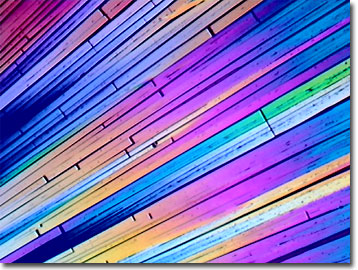Polarized Light Digital Image Gallery
Acetylcholine
Acetylcholine is both a central and peripheral neurotransmitter. Synthesized from dietary choline and acetyl coenzyme A, this neurotransmitter and similar substances play a central role in depression, therapies for Parkinson's and Alzheimer's diseases, and in chemical warfare against insects and humans.

View a second image of crystallized acetylcholine.
Originally referred to as "vagusschtuff", because it was found to be the substance released by the stimulation of the vagus nerve, altering heart beats, acetylcholine was one of the first neurotransmitters discovered. The synaptic action of acetylcholine on the receptor is terminated by enzymatic cleavage with acetylcholinesterase. The choline is then returned to the neuron terminal for resynthesis of acetylcholine.
Either excitatory or inhibitory, acetylcholine's actions are dependent on the type of tissue and the nature of the receptor with which it is interacting. Alkaloids, especially nicotine and muscarine, have specific receptors in the human central nervous system for acetylcholine transmission. Nicotine receptors are selectively found in the brainstem and spinal cord, while the muscarinic receptors are more diffuse in their distribution. Nicotinic responses are fast to initiate, of short duration, and usually excitatory. The neurotoxin from the cobra's venom, which binds specifically to the nicotinic receptor, assisted research scientists in the purification of the receptor protein.
Contributing Authors
Omar Alvarado, Thomas J. Fellers and Michael W. Davidson - National High Magnetic Field Laboratory, 1800 East Paul Dirac Dr., The Florida State University, Tallahassee, Florida, 32310.
BACK TO THE POLARIZED LIGHT IMAGE GALLERY
BACK TO THE DIGITAL IMAGE GALLERIES
Questions or comments? Send us an email.
© 1995-2022 by Michael W. Davidson and The Florida State University. All Rights Reserved. No images, graphics, software, scripts, or applets may be reproduced or used in any manner without permission from the copyright holders. Use of this website means you agree to all of the Legal Terms and Conditions set forth by the owners.
This website is maintained by our
Graphics & Web Programming Team
in collaboration with Optical Microscopy at the
National High Magnetic Field Laboratory.
Last Modification Friday, Nov 13, 2015 at 02:19 PM
Access Count Since September 17, 2002: 13303
Visit the website of our partner in introductory microscopy education:
|
|
